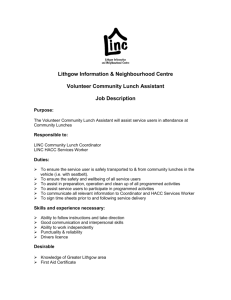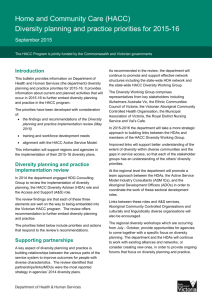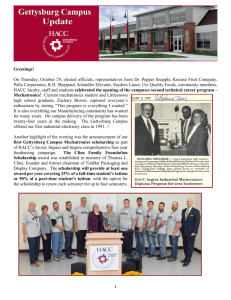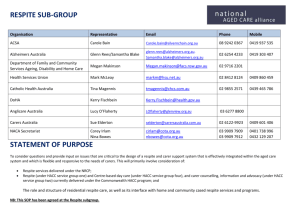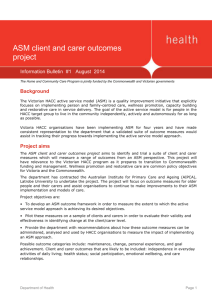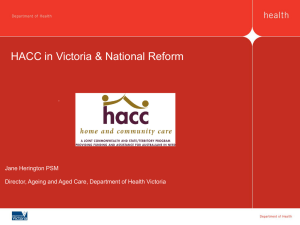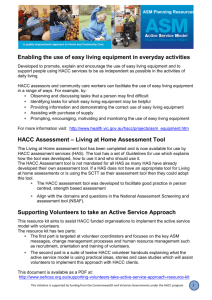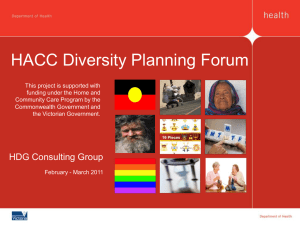Diversity planning 2015-2016_information for HACC agencies
advertisement
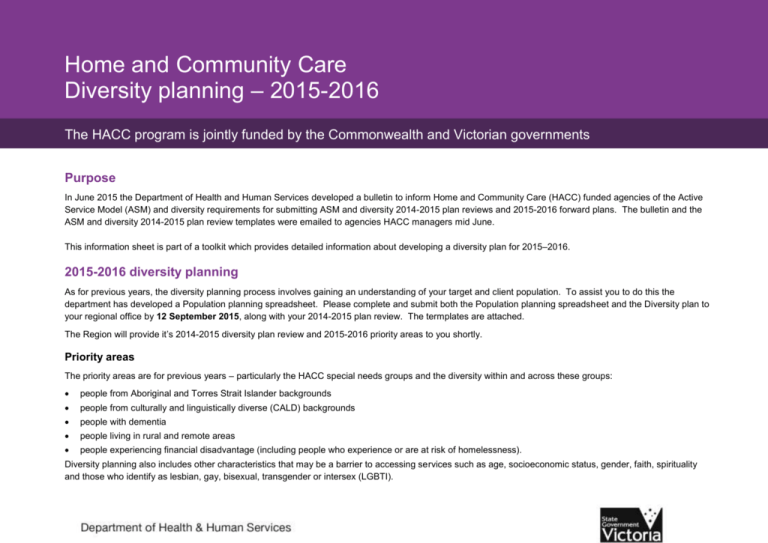
Home and Community Care Diversity planning – 2015-2016 The HACC program is jointly funded by the Commonwealth and Victorian governments Purpose In June 2015 the Department of Health and Human Services developed a bulletin to inform Home and Community Care (HACC) funded agencies of the Active Service Model (ASM) and diversity requirements for submitting ASM and diversity 2014-2015 plan reviews and 2015-2016 forward plans. The bulletin and the ASM and diversity 2014-2015 plan review templates were emailed to agencies HACC managers mid June. This information sheet is part of a toolkit which provides detailed information about developing a diversity plan for 2015–2016. 2015-2016 diversity planning As for previous years, the diversity planning process involves gaining an understanding of your target and client population. To assist you to do this the department has developed a Population planning spreadsheet. Please complete and submit both the Population planning spreadsheet and the Diversity plan to your regional office by 12 September 2015, along with your 2014-2015 plan review. The termplates are attached. The Region will provide it’s 2014-2015 diversity plan review and 2015-2016 priority areas to you shortly. Priority areas The priority areas are for previous years – particularly the HACC special needs groups and the diversity within and across these groups: people from Aboriginal and Torres Strait Islander backgrounds people from culturally and linguistically diverse (CALD) backgrounds people with dementia people living in rural and remote areas people experiencing financial disadvantage (including people who experience or are at risk of homelessness). Diversity planning also includes other characteristics that may be a barrier to accessing services such as age, socioeconomic status, gender, faith, spirituality and those who identify as lesbian, gay, bisexual, transgender or intersex (LGBTI). It’s important that all levels of your organisation are engaged with diversity planning. Some ways to do this can be: Engage key people at various levels of the organisation – board members, managers, coordinators and community care staff and volunteers. Establish a diversity working group. Diversity planning stages The following outlines the stages for developing your agency’s diversity plan 1. Demonstrate an understanding of your HACC target population (the demographics of your catchment area) Target population data by LGA will be provided by the department as for previous years. Other useful data sources are: Local government profiles: www.health.vic.gov.au/modelling/planning/lga.htm City of Greater Dandenong: www.greaterdandenong.com/document/18464/statistical-data-for-victorian-communities (refer to regional profile builder) ABS table builder: www.abs.gov.au/websitedbs/censushome.nsf/home/tablebuilder – Note your regional HACC Diversity Adviser can source ABS data for you using the table builder. For example the number of people from particular countries of birth by age group. Anecdotal information from community members, for example Aboriginal Elders or CALD community leaders. Put this information in columns A, B and C on the Population planning spreadsheet 2. Demonstrate an understanding of the diversity of your HACC client population HACC client population data by region will be provided by the department. The MDS client data will be provided at the regional level because the variability of client numbers gives misleading percentages at the LGA level. Your HACC client data sources include: Minimum Data Set (MDS) – on the Funded Agency Channel (contact your regional HACC PASA for information on how to access the FAC). Your agency’s Community Care Common Standards (CCCS) improvement plan. Anecdotal information from, for example PAG coordinators, HACC coordinators, allied health providers, community care workers and volunteers. Put this information in columns D and E on the attached Population planning spreadsheet. 3. Identify barriers Service access - compare your HACC target population to the client population and identify groups or individuals who may not be accessing your services. Service responsiveness - consider your client population and identify issues with your service’s responses to particular groups or individuals. Attend a regional diversity planning session. Collaborate with other HACC agencies in your catchment to talk about community groups and which agency types and HACC activities they are accessing (or not), and how you might improve referrals and services to these groups. For example agencies in a particular LGA, including the Aboriginal Community Controlled Organisation, may discuss access to the range of allied health services for Aboriginal people. Also seek guidance from agencies, such as ethnospecific agencies, to gain an understanding of how to provide service responses to particular groups or individuals. Contact the sectoral development officers in special interest/peak organisations for advice. These roles are located in Alzheimers Australia Victoria; the Municipal Association of Victoria; the regional HACC Aboriginal networks; the Ethnic Communities Council of Victoria; Val’s Café (LGBTI); and the Royal District Nursing Service. For more information on these roles contact your HACC Diversity Adviser. You are particularly encouraged to engage with and include Access and Support services in your diversity plan (note there is not full statewide coverage of Access and Support services). Ensure input from, for example PAG coordinators, HACC service coordinators, allied health providers, community care workers and volunteers. Decide which priorities your agency would like to focus on for 2015-2016 and put the information in columns F and G on the Population planning spreadsheet. 4. Develop your diversity plan based on the information on your Population planning sheet. Choose 3 – 5 priority areas (relevant to the size of your HACC service) that you want to focus on over the next 12 months. Ensure your actions are SMART – specific, measurable, achievable, realistic and time oriented. You may like to develop a whole of agency diversity plan or include HACC diversity planning in your existing whole of agency planning processes. Transfer the HACC related priorities, actions etc to the HACC diversity planning template. You may like to collaborate with other agencies in your catchment area to develop an integrated local service system diversity plan with shared priorities and actions. If so, ensure the priorities, actions and outcome measures are listed for each agency. Note that each agency must still develop their own diversity plan with their agency’s specific actions and submit the plan to the department. For more information on how to develop your diversity plan: Contact your HACC Diversity Adviser Refer to the Strengthening diversity planning and practice: A guide for Victorian Home and Community Care services (2011) on the Victorian HACC website at www.health.vic.gov.au/hacc/projects/diversity_guide.htm Name of document 4
